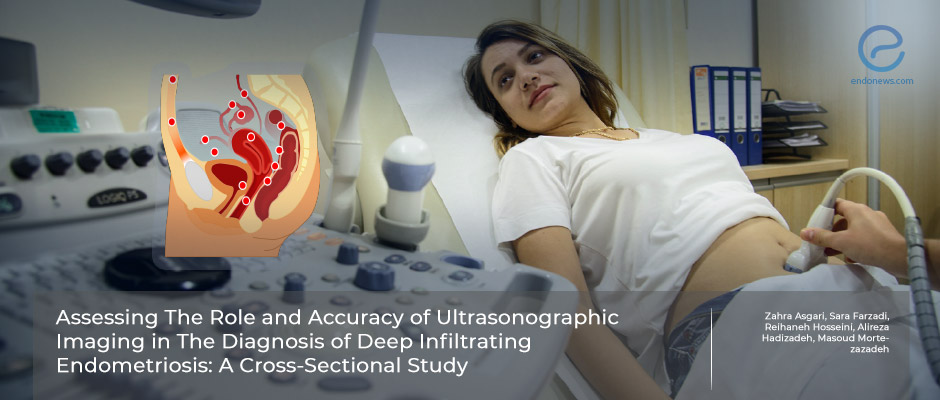How accurate is ultrasonography in evaluating deep infiltrating endometriosis?
Jan 3, 2023
Study shows high overall sensitivity and specificity in the detection of intestinal deep infiltrating endometriosis with ultrasonography
Key Points
Highlight
- Ultrasonographic evaluation in deep infiltrating endometriosis (DIE) lesions seems to be specific and sensitive in terms of accurately detecting the lesions.
Importance
- Identifying the extent of the disease is important in endometriosis patients for precise surgical planning and approach.
What’s done here
- This is a cross-sectional study that included a total of 97 endometriosis patients.
- The findings of the ultrasonographic examination prior to surgery were assessed in terms of sensitivity, specificity, and positive predictive value.
- The results were compared with surgical and pathological diagnoses.
- The age, body mass index, type of endometriosis (DIE or ovarian endometrioma), and location and level of involvement were evaluated.
Key results
- The overall accuracy of ultrasonography in identifying intestinal DIE showed 97.6% sensitivity and 73.8% specificity.
- The laparoscopic assessment was much more diagnostic with 97.6% sensitivity and 97.2% specificity.
- When ultrasonographic findings and pathological diagnoses were compared regarding levels of involvement, the accuracy was lower.
- The findings were also inaccurate in identifying cul de sac and uterosacral ligament involvement with low positive predictive value and sensitivity.
- The higher the BMI was, the less sensitive and specific the ultrasonographic evaluation was proving a negative effect of being overweight.
Limitations
- Poor bowel preparation may reduce the diagnostic accuracy of ultrasonography and the procedure is painful.
- Possibility of missing linear nodules during laparoscopic surgery (particularly in cul de sac) and the lack of sufficient samples for specific groups.
Lay Summary
Deep infiltrating endometriosis (DIE) appears to be the most severe form of endometriosis comprising 15-30% of all endometriosis patients. The difference in the presentation of the lesions ranges from simple adhesions to infiltrative nodules. Even though there is no consensus on evaluating the severity of endometriosis, the American Society of Reproductive Medicine classification is widely used but it falls short of accurately capturing the traits of DIE. It is stated that pelvic ultrasonographic examination including transvaginal and rectal ultrasonography is more accurate in assessing the extent of the disease.
Asgari et al. carried out a cross-sectional study to assess the sensitivity, specificity, and positive predictive value of ultrasonographic examination in precisely detecting intestinal DIE. They compared the results of the imaging with surgical and pathological findings. The study was published in the October 2022 issue of the International Journal of Fertility & Sterility.
A total of 97 patients that presented with severe endometriotic symptoms, who were candidates for surgery, and whose diagnoses were surgically and histologically confirmed were included in the study. The age, body mass index, type of endometriosis (DIE or ovarian endometrioma), and location and level of involvement were evaluated. Even though the laparoscopic assessment was shown to be much more diagnostic with 97.6% sensitivity and 97.2% specificity, the overall accuracy of ultrasonography in identifying intestinal DIE was found to be 97.6% sensitive and 73.8% specific. The authors suggested that ultrasonography could be used as a useful procedure to identify the extent of the disease before surgery.
A lower accuracy was detected when ultrasonographic findings and pathological diagnoses were compared regarding levels of involvement. The findings were not accurate in terms of identifying cul de sac and uterosacral ligament involvement with low positive predictive value and sensitivity. The authors also assessed the effect of obesity and weight on ultrasonographic imaging and it was seen that the higher the BMI was, the less sensitive and specific the ultrasonographic evaluation was.
It was concluded that presurgical ultrasonographical examination can be used as a helpful tool in the evaluation of DIE, especially with adnexal and intestinal lesions. Lastly, the authors suggest in overweight and obese patients ultrasonography should be used in conjunction with other imaging modalities such as magnetic resonance imaging because of the negative effect of the fat impedance in these patients.
Research Source: https://pubmed.ncbi.nlm.nih.gov/36273311/
endometriosis deep infiltrating endometriosis intestinal endometriosis ultrasonography

